Managed futures ETFs have tried – and failed – to gain traction in Europe before, but the market might now be ready for another shot.
In a managed futures strategy, a Commodity Trading Advisor (CTA) uses proprietary trading methods, typically systematic in nature, to assemble a portfolio of futures across a broad range of asset classes.
CTAs primarily use ‘trend-following’ strategies – establishing long or short positions in the hope that an asset’s recent performance trend continues.
These funds tend to do well when markets are exhibiting powerful trends in either direction that endure for a few months to a few years. As the below chart illustrates, CTAs significantly outperformed equities in the 2000s but have lagged painfully since.
Chart 1: Performance of managed futures vs US equities, 2000-present
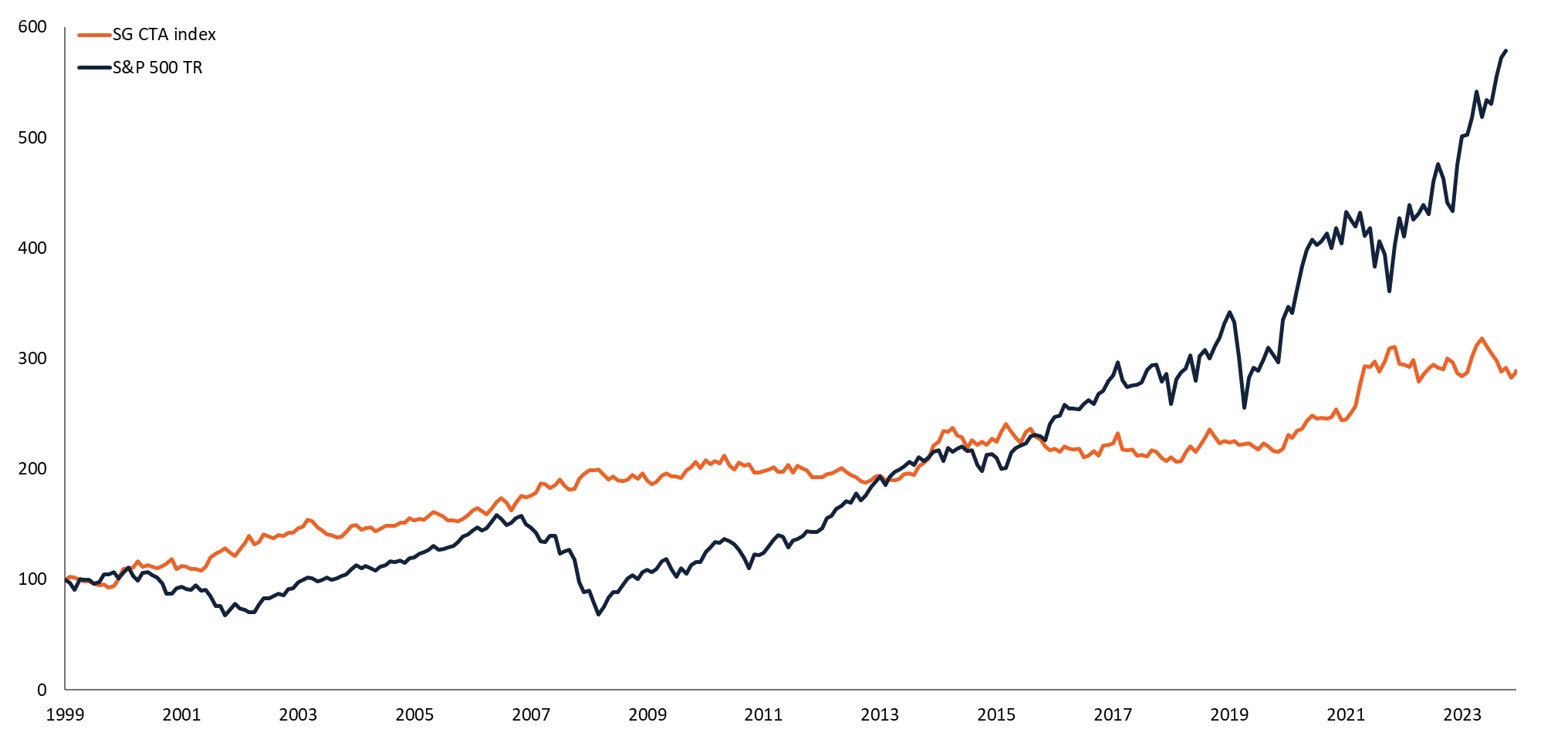
Source: SG Prime Services & Clearing; S&P Dow Jones Indices; ETF Stream calculations. Index values rebased to 100.
The first and to-date only managed futures ETF in Europe came from JP Morgan Asset Management (JPMAM).
In fact, it was one of two products launched as part of JPMAM’s first foray into the European ETF market back in 2017. The other, a long-short strategy, also closed in 2020 with the pair failing to attract sufficient assets.
While managed futures ETFs have attracted some demand in the US – indeed seven products hold assets exceeding $2bn, according to Trackinsight data – no provider has dared to launch an equivalent in Europe since JPMAM's candidate.
If the performance of CTAs turns around, however, fund selectors may look to allocate to these strategies on a more secular basis. With no ETFs currently on the market, providers could be missing out on a winning strategy
Managed futures as a diversifier
In traditional portfolios weighted heavily to conventional asset classes, managed futures strategies can offer significant diversification benefits.
As a handful of academic studies have demonstrated, returns are highly uncorrelated to both equities and bonds meaning an allocation can dampen a portfolio’s volatility and improve risk-adjusted returns.
Additionally, CTAs have “historically demonstrated meaningful downside mitigation in sustained bear markets, without relying on an illiquidity premia,” argued Simon McConnell, head of portfolio construction at Netwealth.
For Matthew Yeates, deputy CIO at 7im, they are under-owned in the multi-asset portfolios of many.
As he pointed out to ETF Stream, they “put up stellar returns in 2022 just as they were needed most – when both equities and bonds fell at the same time.”
Indeed, as the below chart shows, CTAs delivered 17.7% in 2022 while equities and bonds fell 18.1% and 16.2% respectively.
Chart 2: Annualised returns of managed futures vs other asset classes, 2022
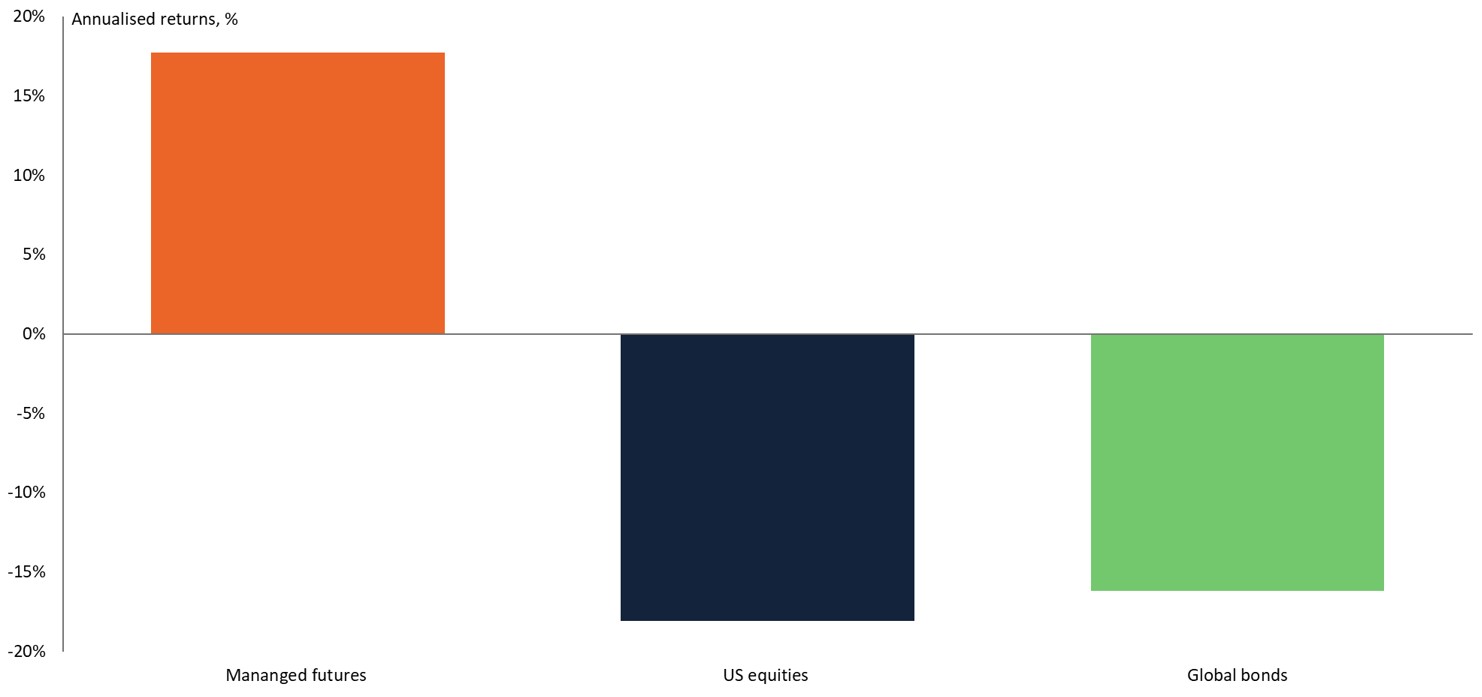
Source: SG Prime Services & Clearing; S&P Dow Jones Indices; Bloomberg Intelligence; ETF Stream calculations. US equities proxied by S&P 500 Total Return. Global bonds proxied by Bloomberg Global-Aggregate Total Return Unhedged USD.
A strategy out of fashion
That said, CTAs have been deeply untrendy for more than a decade. In the 2000s they performed very strongly – a decade with two protracted bear markets in equities and powerful trends across most asset classes.
As the below chart illustrates, CTAs delivered annualised returns of 7.6% over the period – very strong performance in both absolute and relative terms.
Chart 3: Annualised returns of managed futures vs other asset classes, 2000s
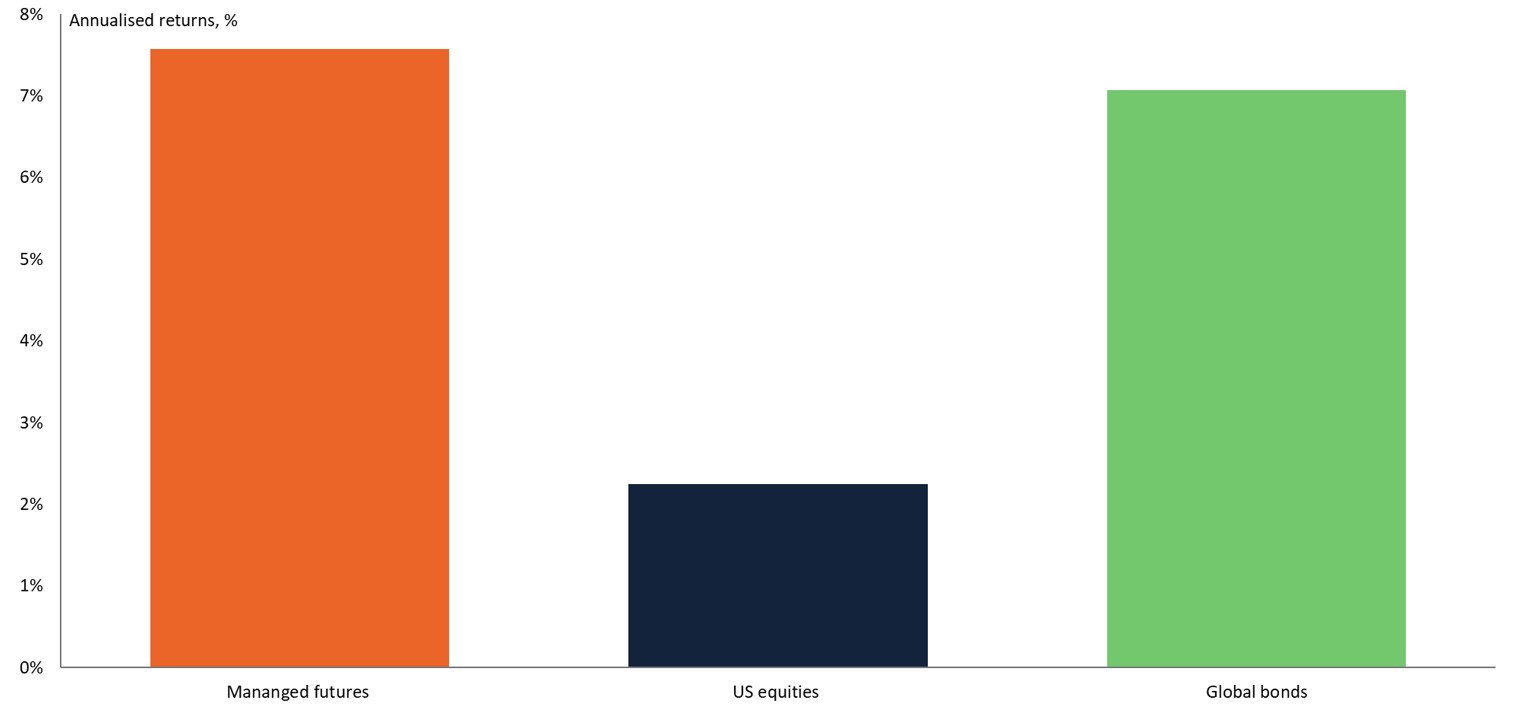
Source: SG Prime Services & Clearing; S&P Dow Jones Indices; Bloomberg Intelligence; ETF Stream calculations. US equities proxied by S&P 500 Total Return. Global bonds proxied by Bloomberg Global-Aggregate Total Return Unhedged USD.
The 2010s was a different story, however. CTAs significantly underperformed both equities and fixed income over the decade.
Chart 4: Annualised returns of managed futures vs other asset classes, 2010s
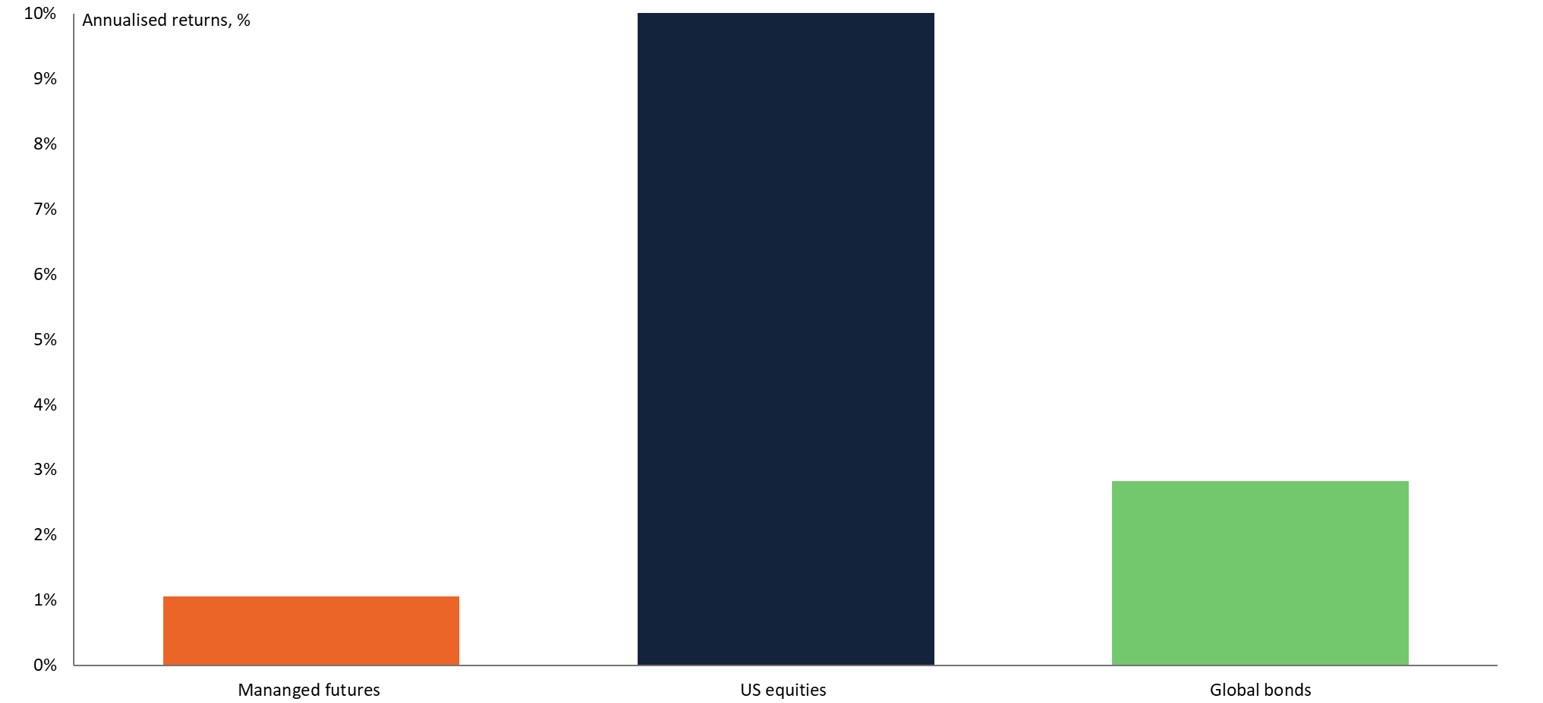
Source: SG Prime Services & Clearing; S&P Dow Jones Indices; Bloomberg Intelligence; ETF Stream calculations. US equities proxied by S&P 500 Total Return. Global bonds proxied by Bloomberg Global-Aggregate Total Return Unhedged USD.
Peter Sleep, investment director at Callanish Capital, said: “There is some debate about why, but the consensus seems to suggest that repeated government intervention and quantitative easing (QE) prevented strong trends emerging in markets.”
Not only can interventions prevent trends emerging given policy is generally designed to achieve stability, but interventions, if sudden and unexpected, can cause steep reversals in markets. This is painful for strategies latched on to established trends.
As a result, managed futures funds commanded substantial inflows during the 2000s but those flows have well and truly dried up, as the following chart illustrates.
Chart 5: Managed futures industry AUM, 1990-present
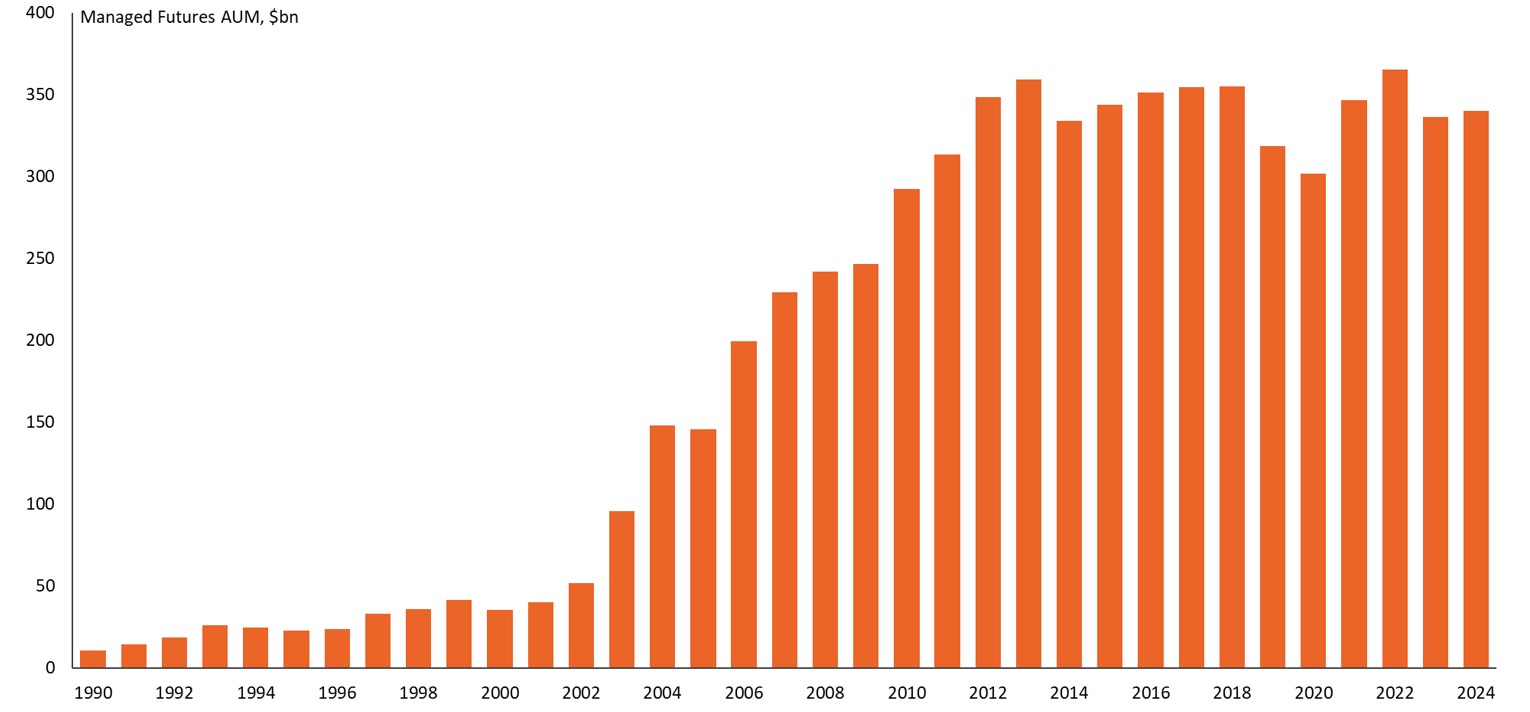
Source: BarclayHedge
Trend to become trendy again?
If relative and absolute performance improves, however, then inflows could be set to reappear.
“Managed futures will return to the top of fund buyers’ shopping lists if they show good performance,” asserted Sleep.
“Right now, the returns of the US equity market are so strong that many investors do not see the need for a diversifier with recent, indifferent investment performance,” he added.
Andrew Beer, managing member at DBi, a firm with a managed futures ETF in the US, agrees. For him, “60/40 portfolios worked so well for the first two years of the millennium that diversifiers were elective. In the 2020s they will become mandatory.”
Indeed, the negative correlation between stocks and bonds over the period is a critical reason for trend-following’s fall from fashion. With bonds providing an adequate cushion during equity market selloffs, there was little need for alternatives of this kind in a portfolio.
That relationship was challenged in 2022, however. Inflation returned and stocks and bonds slumped simultaneously causing 60/40 portfolios to have their worst year on record.
According to McConnell, a shifting macroeconomic landscape challenges the notion that the negative stock-bond correlation will be maintained going forward.
Managed futures ETFs?
Although there are currently no managed futures funds in the European ETF roster, a handful of UCITS mutual funds exist, of which Beer’s iGMP DBi Managed Futures Fund (DMBF) is one.
While the assets under management are not insubstantial – the AQR Managed Futures UCITS Fund, for example, housed $635m as at 31 October – in the context of the wider industry they represent a miniscule fraction of assets.
That said, the size of the prize could be set to grow substantially in the coming years should CTA performance pick up. ETF issuers must therefore consider whether to push for first-mover advantage in the space.
Bringing a product to market does have its challenges, however. One is getting to sufficient size. If products remain small, this could impact the ability of authorised participants (APs) to provide liquidity in a cost-efficient manner.
“If investors are being asked to pay wide bid-offer spreads, layered on top of reasonably high ongoing charges figures (OCFs), then that is a high hurdle to overcome,” said McConnell.
Indeed, for this reason “it is much easier to grow a $50m mutual fund to $100m than it is grow an ETF from $50m to $100m,” explained Beer.
Another is market fragmentation. According to Beer, the ETF launching process “is more complicated and cumbersome than in the US given ETFs often need to be listed on multiple exchanges.”
Perhaps the steepest hurdle, however, is education. For Beer, investors are “woefully under-invested” in these strategies and the diversification benefits they can offer need more highlighting. Wealth managers also need help to justify these allocations to their underlying clients.
The question, then, is how to provide exposure. Historically providers employed proprietary algorithms to identify trends and to dial up and down their cross-asset class exposures; but some, like DBi, seek to mimic the returns of a managed futures index.
“Historically trend-following was seen as a classic 2%+20% performance fee strategy. However, there is an increasing group of trend-following vehicles that focus on the ‘beta’ of the style in general – looking to outperform the average trend-following manager by charging lower fees,” explained Yeates.
“We think both categories are interesting but it’s important to be clear on the incremental returns you get for the features of the more complex implementations,” he added.
As to whether JPMAM would consider a re-run of its European managed futures ETF, the firm declined to comment.
It is clear the products have now entered the mainstream in the US, with BlackRock filing to launch an actively managed trend-following ETF with the Securities and Exchange Commission (SEC) on Wednesday.
The key questions now are whether an issuer will be brave enough to buck the trend in Europe and whether ETF investors will be more open-minded to CTAs.